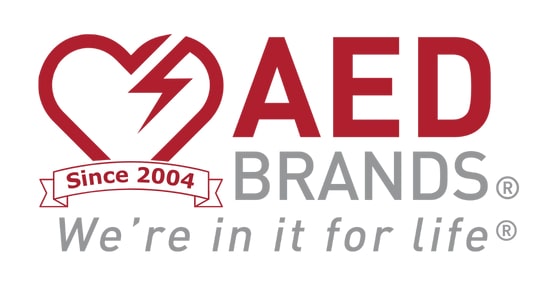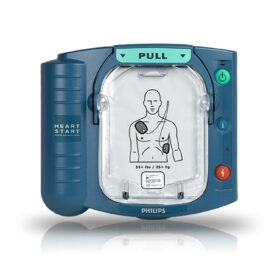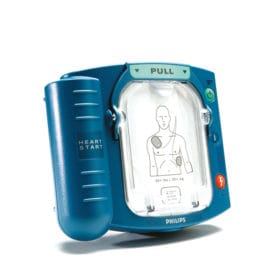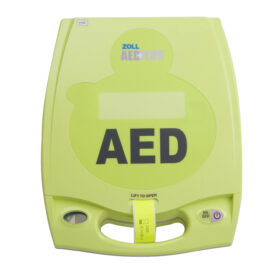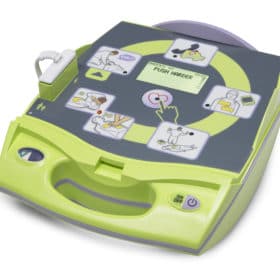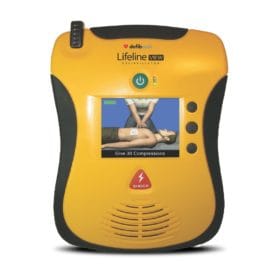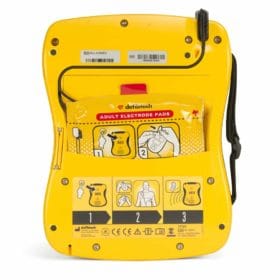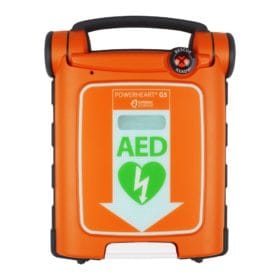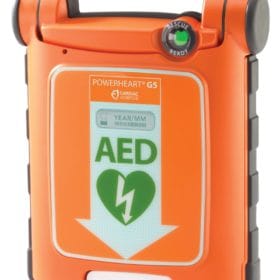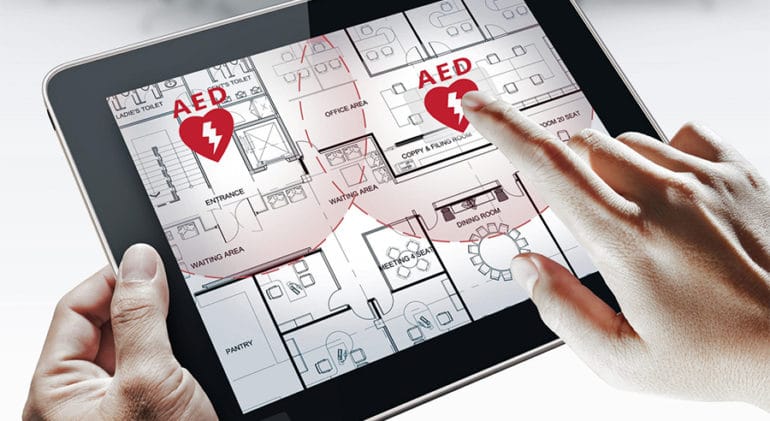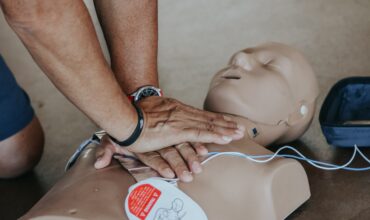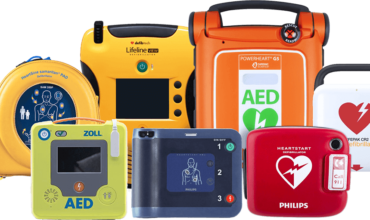
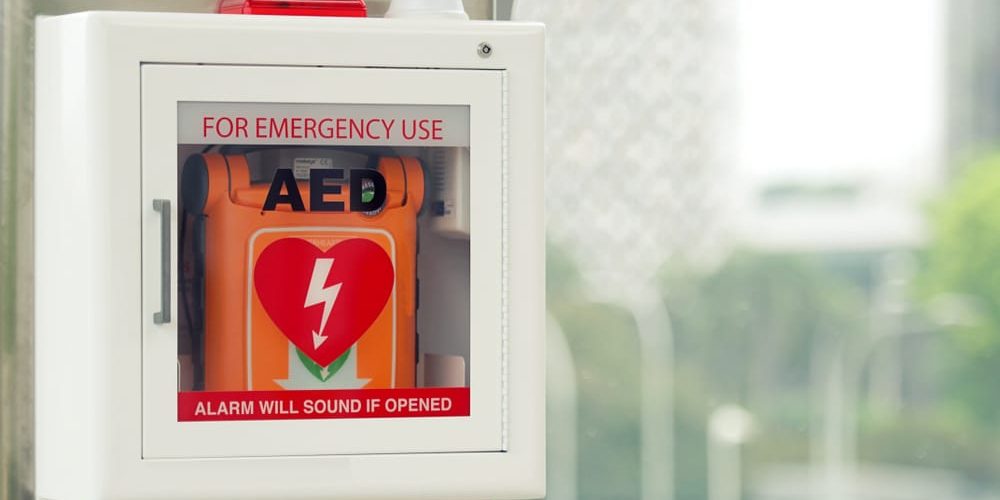
What is an AED?
AED stands for “Automated External Defibrillator.” It is a portable electronic device used to treat sudden cardiac arrest by delivering an electric shock to the heart to restore its normal rhythm.
It’s designed to automatically analyze a person’s heart rhythm and deliver an electric shock to restore a normal heartbeat if necessary. AEDs are commonly found in public places such as airports, sports arenas, and schools, as well as in many healthcare settings. They are simple to use, even for people without medical training, and can significantly improve a person’s chances of surviving a sudden cardiac arrest.
If you’ve ever wondered what those devices inside of cabinets are called or used for, you have come to the right place.
They may come in different shapes, sizes, and colors, but their primary function is the same – to treat victims of Sudden Cardiac Arrest, which is responsible for causing the deaths of over 360,000 Americans each year.
The modern AED machine is a sophisticated and high-tech piece of medical equipment, but it is designed to be used by everyday people and bystanders who can provide first aid much faster than 911. The fate of Sudden Cardiac Arrest victims can be greatly impacted by each passing minute, with some studies showing that the chances of survival on average drop 10% for each minute that passes.
Who invented the AED?
Dr. Frank Pantridge, an Irish military doctor who later became a cardiologist, in 1965. Prior to the invention of AEDs, it was widely understood that a significant number of deaths resulting from cardiac arrest occurred when the heart lost its normal beating rhythm and went into an abnormal rhythm known as ventricular fibrillation (VF) or ventricular tachycardia (VT).
This irregularity of heart rhythm can cause the heart to stop pumping blood effectively, and without prompt intervention, can lead to death.
AEDs are designed to detect these abnormal rhythms and deliver a controlled electric shock to the heart, with the goal of restoring normal heart rhythm and increasing the chances of survival for the person experiencing cardiac arrest.
The widespread availability and ease of use of AEDs have made them a valuable tool in emergency situations and have saved countless lives
Do You Need Training to Operate an AED?
While AEDs are designed to be user-friendly and provide voice prompts to guide the user through the process, it is recommended that individuals receive formal training before using an AED. Training can help users feel more comfortable and confident using the device in an emergency and can provide valuable knowledge on how to perform CPR and other life-saving measures.
So, while it is technically possible for someone without training to use an AED, it is recommended that individuals receive formal training to ensure that they can use the device properly and effectively in an emergency situation.
Shop FDA Approved AEDs
View cart “Defibtech View AED” has been added to your cart.
Hot
Hot
Hot
What should I consider when purchasing an AED?
Maintenance – In most cases, AED maintenance is as simple as replacing the pads and batteries when necessary. For more devices, the pads must be replaced every two years or after use during an SCA. For batteries, most types must be replaced every four years. The cost varies for AED Pads and AED Batteries depending on which device you select. Most batteries cost between $150-$400 whereas adult AED Pads cost around $50-120 depending on the device.
Newer AED devices now feature some sort of CPR feedback or CPR coaching to help lay responders or bystanders deliver high-quality CPR. AED machines like the ZOLL AED Plus will let the responder know how their CPR compressions are and give feedback in real-time. It can detect whether a responder is pushing too fast, too slow, too hard, or too soft.
What Are The Steps to Using an AED?
Step 1: Know the Signs of Cardiac Arrest
Assess the person’s condition. Check to see if the person is breathing and has a pulse. If you cannot feel a pulse and the person is not breathing, immediately call for emergency help. Time is of the essence, so don’t hesitate to act quickly and seek assistance from anyone nearby. Look for an AED nearby as they are commonly found in public places.
Step 2: Turn on the AED
Turn on the AED. Once the AED is retrieved, turn it on. The device will provide step-by-step voice instructions that guide you through the process of checking for breathing and a pulse and how to position the electrode pads on the person’s chest.
Step 3: Deploy the AED
Apply the electrode pads. Attach the electrode pads to the person’s bare chest as directed by the AED. The pads will have illustrations to help with proper placement. Once the pads are in place, the AED will automatically measure the person’s heart rhythm and determine if a shock is needed.
Step 4: Deliver the Shock
If the AED determines that a shock is needed, it will provide instructions on how to deliver it. The machine will tell the user to stand back and push a button to deliver the shock. It is important to make sure that no one is touching the person or anything that is in contact with the person when the shock is delivered.
Step 5: Administer CPR
After the shock is delivered, if CPR is still needed, the AED will provide instructions on how to perform CPR. Continue administering CPR until emergency medical services arrive. The AED can be used again if necessary. Remember to stay calm and follow the AED’s voice prompts, as the device is designed to guide you through the process to help save a life.
5 Facts About AEDs
AEDs can increase the survival rate for people experiencing sudden cardiac arrest by up to 75 percent. When used within the first few minutes of cardiac arrest, an AED can restore the heart’s normal rhythm and increase the chances of survival.
AEDs are very easy to use, even for people with no medical training. The device will provide step-by-step instructions to guide the user through the process of attaching the electrodes and delivering the shock if needed. Some devices will shock the patient automatically.
AEDs can be found in a wide variety of locations, including airports, shopping malls, and sports arenas. In some countries, AEDs are required by law to be present in certain public places.
AEDs are designed to be safe for use on children as well as adults. Some AED models have pediatric pads that are specifically designed for use on children, and they will adjust the shock energy to suit the child’s size.
Most AEDs are equipped with self-diagnostic capabilities to ensure that they are always ready for use in an emergency. The device will perform a self-test when turned on and will alert the user if there are any issues with the device or the electrodes. This feature helps to ensure that the AED is always ready to be used when needed.
FAQs About AEDs
Who can use an AED? AEDs are designed to be used by anyone, regardless of whether they have medical training. The device will provide step-by-step instructions to guide the user through the process of attaching the electrodes and delivering the shock if needed.
When should an AED be used? An AED should be used as soon as possible when someone is experiencing sudden cardiac arrest. The device will analyze the person’s heart rhythm and determine if a shock is needed to restore a normal rhythm.
Are AEDs safe to use? Yes, AEDs are safe to use when used according to the manufacturer’s instructions. The device will only deliver a shock if it detects an abnormal heart rhythm that requires treatment. The device will also provide voice prompts to guide the user through the process.
Do AEDs require special training to use? While AEDs are designed to be user-friendly, it is recommended that individuals receive formal training before using an AED. Training can help users feel more comfortable and confident in using the device in an emergency situation.
How long does an AED battery last? The battery life of an AED can vary depending on the model and manufacturer. Generally, AED batteries can last between 2 and 5 years. It is important to regularly check the battery status and replace the battery as needed to ensure that the device is always ready for use in an emergency.
Share
Share on facebook
Share on twitter
Share on linkedin
AED Brands
Implementation Guide

